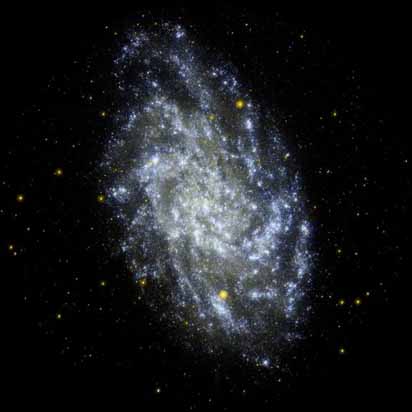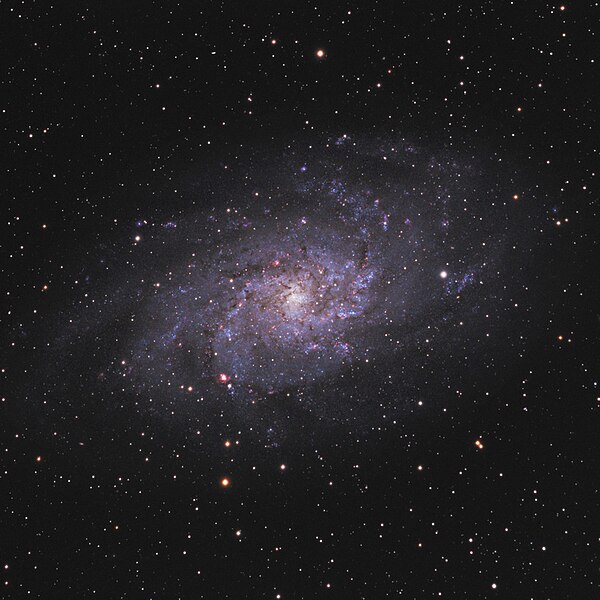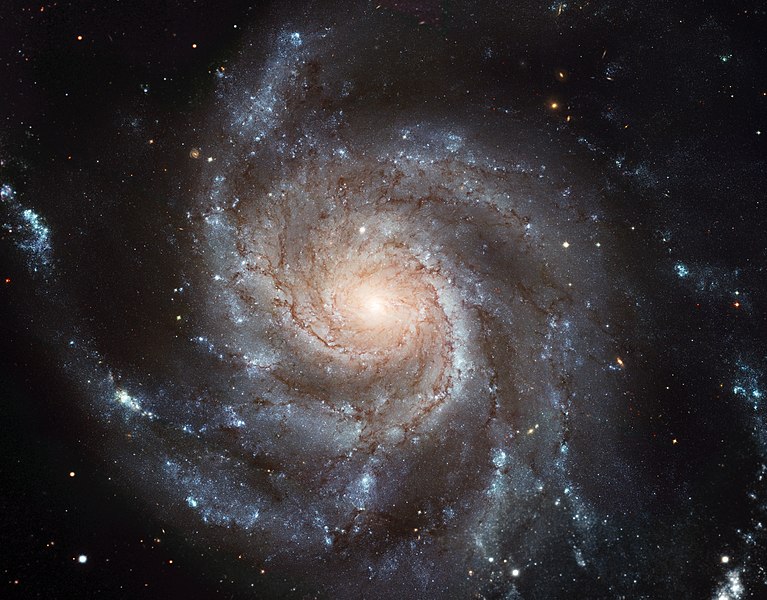APOD: Facing NGC 6946 (2008 Aug 15)
- neufer
- Vacationer at Tralfamadore
- Posts: 18805
- Joined: Mon Jan 21, 2008 1:57 pm
- Location: Alexandria, Virginia
APOD: Facing NGC 6946 (2008 Aug 15)
http://apod.nasa.gov/apod/ap080815.html
http://flickr.com/photos/robertmiller/421558327/
http://apod.nasa.gov/apod/ap050125.html
<<Why is this galaxy so active? Nearby spiral galaxy NGC 6946 is undergoing a tremendous burst of star formation with no obvious cause. In many cases spirals light up when interacting with another galaxy, but NGC 6946 appears relatively isolated in space. Located just 10 million light years away toward the constellation of Cepheus, this beautiful face-on spiral spans about 20,000 light years and is seen through a field of foreground stars from our Milky Way Galaxy. The center of NGC 6946 is home to a nuclear starburst itself, and picturesque dark dust is seen lacing the disk along with bright blue stars, red emission nebulas, fast moving gas clouds, and unusually frequent supernovas. A suggested explanation for the high star formation rate is the recent accretion of many primordial low-mass neutral hydrogen clouds from the surrounding region.>>
---------------------------------------
http://apod.nasa.gov/apod/ap990322.html
<<Where do stars form in galaxies? One way to find this out it to look for glowing hydrogen, a material common to hot star-forming regions. To find large areas of glowing hydrogen, the Hubble Space Telescope's NICMOS instrument surveyed about 100 nearby spiral galaxies. Six of these galaxies are shown above: NGC 5653, NGC 3593, NGC 891, NGC 6946, NGC 4826, and NGC 2903. Each galaxy is many millions of light-years distant. NICMOS was calibrated to isolate a very specific type of light emitted by hydrogen gas in the infrared. This emission is colored red in the above photograph, and is relatively free from absorption by dark dust. These photographs show that stars are forming more vigorously in some parts of galaxies than others.>>
http://flickr.com/photos/robertmiller/421558327/
http://apod.nasa.gov/apod/ap050125.html
<<Why is this galaxy so active? Nearby spiral galaxy NGC 6946 is undergoing a tremendous burst of star formation with no obvious cause. In many cases spirals light up when interacting with another galaxy, but NGC 6946 appears relatively isolated in space. Located just 10 million light years away toward the constellation of Cepheus, this beautiful face-on spiral spans about 20,000 light years and is seen through a field of foreground stars from our Milky Way Galaxy. The center of NGC 6946 is home to a nuclear starburst itself, and picturesque dark dust is seen lacing the disk along with bright blue stars, red emission nebulas, fast moving gas clouds, and unusually frequent supernovas. A suggested explanation for the high star formation rate is the recent accretion of many primordial low-mass neutral hydrogen clouds from the surrounding region.>>
---------------------------------------
http://apod.nasa.gov/apod/ap990322.html
<<Where do stars form in galaxies? One way to find this out it to look for glowing hydrogen, a material common to hot star-forming regions. To find large areas of glowing hydrogen, the Hubble Space Telescope's NICMOS instrument surveyed about 100 nearby spiral galaxies. Six of these galaxies are shown above: NGC 5653, NGC 3593, NGC 891, NGC 6946, NGC 4826, and NGC 2903. Each galaxy is many millions of light-years distant. NICMOS was calibrated to isolate a very specific type of light emitted by hydrogen gas in the infrared. This emission is colored red in the above photograph, and is relatively free from absorption by dark dust. These photographs show that stars are forming more vigorously in some parts of galaxies than others.>>
Art Neuendorffer
Re: NGC 6946 Pinwheel (APOD 15 Aug 2008)
http://antwrp.gsfc.nasa.gov/apod/ap050125.html
...[NGC 6946] this beautiful face-on spiral spans about 20,000 light years...
http://antwrp.gsfc.nasa.gov/apod/ap080815.html
...[NGC 6946] Nearly 40,000 light-years across...
That is quite a growth in only three years!
...[NGC 6946] this beautiful face-on spiral spans about 20,000 light years...
http://antwrp.gsfc.nasa.gov/apod/ap080815.html
...[NGC 6946] Nearly 40,000 light-years across...
That is quite a growth in only three years!
- neufer
- Vacationer at Tralfamadore
- Posts: 18805
- Joined: Mon Jan 21, 2008 1:57 pm
- Location: Alexandria, Virginia
Re: NGC 6946 Pinwheel (APOD 15 Aug 2008)
NGC 6946 is about 30,000 light-years acrossCase wrote:http://antwrp.gsfc.nasa.gov/apod/ap050125.html
...[NGC 6946] this beautiful face-on spiral spans about 20,000 light years...
http://antwrp.gsfc.nasa.gov/apod/ap080815.html
...[NGC 6946] Nearly 40,000 light-years across...
That is quite a growth in only three years!
[ = 0.003 radians x ~10 million light-years].
However, despite numerous supernova for fixing NGC 6946's exact distance (and therefore its exact size) there is too much uncertainty vis-a-vis the amount of Milky Way absorption.
(It's sort of like observing the fireworks of the Olympic Opening Ceremony through a heavy Beijing smog.)
--------------------------------------------
http://en.wikipedia.org/wiki/NGC_6946
<<NGC 6946 [apparent dimensions : 11′.5 × 9′.8 ~ 0.003 radians], also known as the "Fireworks Galaxy", is an intermediate spiral galaxy about 10 million light-years away, on the border between the constellations Cepheus and Cygnus. It was discovered by William Herschel on September 9, 1798. NGC 6946 is highly obscured by interstellar matter of the Milky Way galaxy, as it is quite close to the galactic plane. Nine supernovae (SN 1917A, SN 1939C, SN 1948B, SN 1968D, SN 1969P, SN 1980K, SN 2002hh, SN 2004et, and SN 2008S) were observed in NGC 6946.>>
--------------------------------------------
Art Neuendorffer
-
Cosmic Voyager
- Asternaut
- Posts: 3
- Joined: Mon May 12, 2008 9:45 pm
- neufer
- Vacationer at Tralfamadore
- Posts: 18805
- Joined: Mon Jan 21, 2008 1:57 pm
- Location: Alexandria, Virginia
http://www.seds.org/messier/xtra/ngc/n6946.htmlCosmic Voyager wrote:To which group (Local Group or whatever?) does belong this galaxy?
<<NGC 6946 is a rather nearby spiral galaxy, which at one time was suspected to be an outlying member of the Local Group (Hubble 1936). It is highly obscured by interstellar matter of the Milky Way galaxy, as it is quite close to the galactic plane.>>
"I don't want to belong to any club that would have me as a member." - Groucho Marx
Art Neuendorffer
- neufer
- Vacationer at Tralfamadore
- Posts: 18805
- Joined: Mon Jan 21, 2008 1:57 pm
- Location: Alexandria, Virginia
Re: NGC 6946 Pinwheel (APOD 15 Aug 2008)
http://www.universetoday.com/81801/m33s-object-x/#more-81801 wrote:
M33′s “Object-X”
by Jon Voisey on December 18, 2010
<<Often times, objects that are unremarkable in one portion of the spectra, can often be vivid in others. In M33, the Triangulum Galaxy, a star that’s barely visible in the optical, stands out as the second brightest source (and single brightest single star) in the mid-infrared. This unusual star has been the target of a recent study, led by Rubab Khan at the Ohio State University and may help astronomers to understand an unusual supernova from 2008.
The supernova 2008S occurred February first in NGC 6946, the Fireworks Galaxy. Since it happened in a galaxy that is relatively nearby, astronomers seized the opportunity to explore the progenitor star in archival images. Yet images from the Large Binocular Telescope and other optical observatories could not find a star that could be identified as a parent. Instead, the detection of the star responsible came from Spitzer, an infrared observatory. Observations from this instrument indicated that the star responsible may have been unexpectedly low mass for such a powerful explosion leading other astronomers to question whether or not SN 2008S was a true supernova, or merely an impostor in the form of an eruption of a Luminous Blue Variable (LBV), which tend to be more massive stars and would be in stark contradiction to the Spitzer findings.
Yet, regardless of the nature of the nature of SN 2008S, teams all seemed to agree that the progenitor had only been detected in the infrared because it was veiled by a thick curtain of dust. So to help better understand this class of dusty stars, astronomers have been working to uncover more of them, against which they can test their hypotheses.
To find these objects, astronomers have been searching the infrared portion of the spectrum for objects that are exceptionally bright yet lack optical counterparts. The brightest of the stellar sources in M33 features faint star in the red portion of the optical spectrum from the Local Group Galaxies Survey published in 2007, but no star at all in archival records with similar limiting magnitudes from 1949 and 1991. The authors of the new study have dubbed this odd source, Object-X.
The team rules out the possibility that the object could be a young stellar object (YSO), blocked by a thick dust disc along the line of sight, noting that models of even the thickest dust discs still predict more light to be scattered back along the line of sight. Instead, the team concludes that Object-X must be a self-obscured star that has undergone relatively recent mass loss which has cooled to form either graphite or silicate dust. Depending on which type of dust is predominant, the team was able to fit the data to two wildly different temperatures for the star: either 5000 K for graphite, or 20,000 K for the silicate. In all cases, the predicted mass for the central star was always greater than 30 solar masses.
In general, there are two mechanisms by which a star can eject material to form such a curtain. The first is through stellar winds, which increase as the star enters the red giant phase, swelling up and lowering the force of gravity near the surface. The second is “impulsive mass ejections” in which stars shudder and throw mass off that way. A classical example of this is Eta Carinae. The team predicts from the features they found, that Object-X is most likely a cool hypergiant. The fact that the star was completely obscured until very recently hints that the mass loss is not constant (as stellar wind), but patchy, coming from frequent eruptions. As the shell of dust expands, the star should reemerge in the optical, becoming visible again in the next few decades.>>
Art Neuendorffer
Re: NGC 6946 Pinwheel (APOD 15 Aug 2008)
???  ???
???
http://en.wikipedia.org/wiki/Triangulum_Galaxy wrote: The Triangulum Galaxy is a spiral galaxy approximately 3 million light years (ly) from Earth in the constellation Triangulum. It is catalogued as Messier 33 or NGC 598, and is sometimes informally referred to as the Pinwheel Galaxy, a moniker it shares with Messier 101. The Triangulum Galaxy is the third-largest member of the Local Group of galaxies, which includes the Milky Way Galaxy, the Andromeda Galaxy and about 30 other smaller galaxies. It is one of the most distant permanent objects that can be viewed with the naked eye.
http://asterisk.apod.com/vie ... =9&t=22176
http://en.wikipedia.org/wiki/NGC_6946 wrote: NGC 6946, (also known as the Fireworks Galaxy, Arp 29, and Caldwell 12), is an intermediate spiral galaxy about 22 million light-years away, on the border between the constellations Cepheus and Cygnus. It was discovered by William Herschel on September 9, 1798. NGC 6946 is highly obscured by interstellar matter of the Milky Way galaxy, as it is quite close to the galactic plane. Nine supernovae (SN 1917A, SN 1939C, SN 1948B, SN 1968D, SN 1969P, SN 1980K, SN 2002hh, SN 2004et, and SN 2008S) have been observed in NGC 6946.
http://en.wikipedia.org/wiki/Pinwheel_Galaxy wrote: The Pinwheel Galaxy (also known as Messier 101 or NGC 5457) is a face-on spiral galaxy distanced 25 million light-years (eight megaparsecs) away in the constellation Ursa Major, first discovered by Pierre Méchain on March 27, 1781, and communicated to Charles Messier who verified its position for inclusion in the Messier Catalogue as one of its final entries.
http://asterisk.apod.com/vie ... =9&t=16761
Know the quiet place within your heart and touch the rainbow of possibility; be
alive to the gentle breeze of communication, and please stop being such a jerk. — Garrison Keillor
alive to the gentle breeze of communication, and please stop being such a jerk. — Garrison Keillor
Re: NGC 6946 Pinwheel (APOD 15 Aug 2008)
Object-X: The Brightest Mid-IR Point Source in M33 - R Khan et alneufer wrote:http://www.universetoday.com/81801/m33s-object-x/#more-81801 wrote:
M33′s “Object-X”
by Jon Voisey on December 18, 2010
- arXiv.org > astro-ph > arXiv:1012.3457 > 15 Dec 2010
Know the quiet place within your heart and touch the rainbow of possibility; be
alive to the gentle breeze of communication, and please stop being such a jerk. — Garrison Keillor
alive to the gentle breeze of communication, and please stop being such a jerk. — Garrison Keillor
- NoelC
- Creepy Spock
- Posts: 876
- Joined: Sun Nov 20, 2005 2:30 am
- Location: South Florida, USA; I just work in (cyber)space
- Contact:
Re: NGC 6946 Pinwheel (APOD 15 Aug 2008)
I was thinking I'd like to find where Object-X actually is in M33, but I don't find the coordinates anywhere online after a fair bit of searching. Do any of you know?
Edit: Never mind, I found it: R.A.=1h33m24.s1 and Dec.=+30◦25′34.′′8
Here's where it is (note, click this image for a close-up view):

-Noel
Edit: Never mind, I found it: R.A.=1h33m24.s1 and Dec.=+30◦25′34.′′8
Here's where it is (note, click this image for a close-up view):

-Noel
- neufer
- Vacationer at Tralfamadore
- Posts: 18805
- Joined: Mon Jan 21, 2008 1:57 pm
- Location: Alexandria, Virginia
Re: NGC 6946 Pinwheel (APOD 15 Aug 2008)
Oh.................yeah; I see it now, Noel.NoelC wrote:
I was thinking I'd like to find where Object-X actually is in M33, but I don't find the coordinates anywhere online after a fair bit of searching. Do any of you know?
Edit: Never mind, I found it: R.A.=1h33m24.s1 and Dec.=+30◦25′34.′′8
Here's where it is):
I don't know how I could have missed it.
Art Neuendorffer
- NoelC
- Creepy Spock
- Posts: 876
- Joined: Sun Nov 20, 2005 2:30 am
- Location: South Florida, USA; I just work in (cyber)space
- Contact:
Re: NGC 6946 Pinwheel (APOD 15 Aug 2008)
My arrow may be off a hair. Not sure whether it's "barely visible" in this DSS image or not.
-Noel
-Noel
Re: NGC 6946 Pinwheel (APOD 15 Aug 2008)
Noel, if one clicks on the second image, a third image comes to screen, GREATLY enlarged, but with no arrows. Is the third image part of the enlargement or just something extra that found it's way in? If it's part of what should be there, there's no arrow to reference where to look.NoelC wrote:My arrow may be off a hair. Not sure whether it's "barely visible" in this DSS image or not.
-Noel
To find the Truth, you must go Beyond.
- NoelC
- Creepy Spock
- Posts: 876
- Joined: Sun Nov 20, 2005 2:30 am
- Location: South Florida, USA; I just work in (cyber)space
- Contact:
Re: NGC 6946 Pinwheel (APOD 15 Aug 2008)
The big image is much larger than your browser window at 5586 x 8808 pixels, so you'll have to scroll it to see the position of the object at the lower-right of the galaxy. If you wait a while for the image to load, when it finishes the browser should downsize it to fit in your browser window entirely, after which you should be able to click on the tiny arrow to enlarge it.
This is the full resolution of the data from the STScI POSS2 Digitized Sky Survey database. Still, it's hard to differentiate very dim objects from grain in the photographic plates.
-Noel
This is the full resolution of the data from the STScI POSS2 Digitized Sky Survey database. Still, it's hard to differentiate very dim objects from grain in the photographic plates.
-Noel
Re: NGC 6946 Pinwheel (APOD 15 Aug 2008)
OH-yeah, nice BIG green arrow! but it looks like it's just pointing at a piece of background. we need better eyes! 
To find the Truth, you must go Beyond.
- neufer
- Vacationer at Tralfamadore
- Posts: 18805
- Joined: Mon Jan 21, 2008 1:57 pm
- Location: Alexandria, Virginia
Re: NGC 6946 Pinwheel (APOD 15 Aug 2008)

NoelC wrote:
The big image is much larger than your browser window at 5586 x 8808 pixels, so you'll have to scroll it to see the position of the object at the lower-right of the galaxy. If you wait a while for the image to load, when it finishes the browser should downsize it to fit in your browser window entirely, after which you should be able to click on the tiny arrow to enlarge it.
This is the full resolution of the data from the STScI POSS2 Digitized Sky Survey database. Still, it's hard to differentiate very dim objects from grain in the photographic plates.
Art Neuendorffer
- NoelC
- Creepy Spock
- Posts: 876
- Joined: Sun Nov 20, 2005 2:30 am
- Location: South Florida, USA; I just work in (cyber)space
- Contact:
Re: NGC 6946 Pinwheel (APOD 15 Aug 2008)
I agree. Without going to the Hubble archives it's the deepest image I can lay hands on.beyond wrote:it looks like it's just pointing at a piece of background. we need better eyes!
-Noel



